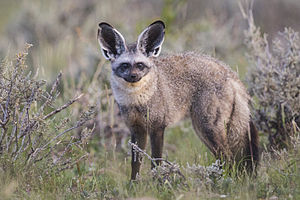큰귀여우
큰귀여우(Otocyon megalotis)는 아프리카 사바나 지역에서 발견되는 여우의 일종이다. 박쥐귀여우라는 이름으로도 알려져 있으며, 큰 귀를 갖고 있어서 붙여진 이름이다.[4] 큰 귀로 체온조절을 한다.[2] 화석 기록에 의하면, 이 개과 동물은 약 80여 만년 전 플라이스토세 중기 동안에 처음 나타났다.[4] 개과 동물의 선조 형태를 닮은 개과의 기저 분류군의 일종으로 간주되고 있다.[5] 큰귀여우는 황갈색을 띠며, 검은 귀와 다리 그리고 얼굴 일부에 반점이 있다. 평균 몸길이는 55cm이고 귀 크기는 13cm 정도이다. 큰귀여우속(Otocyon)의 유일종이다.[1] 학명 "오토키온"(Otocyon)은 "귀"(ear)라는 의미의 그리스어 "오투스"(otus)와 "개"(dog)라는 의미의 "키온"(cyon)의 합성어에서 유래했다. 반면에 종소명 "메갈로티스"(megalotis)는 "크다"(large)라는 의미의 그리스어 "메가"(mega)와 "귀"(ear)라는 의미의 그리스어 "오투스"(otus)의 합성어이다.[2]
|
| ||
|---|---|---|
 박쥐귀여우 | ||
| 생물 분류ℹ️ | ||
| 계: | 동물계 | |
| 문: | 척삭동물문 | |
| 강: | 포유강 | |
| 목: | 식육목 | |
| 과: | 개과 | |
| 속: | 큰귀여우속 (Otocyon) Müller, 1835 | |
| 종: | 큰귀여우 (O. megalotis) | |
| 학명 | ||
| Otocyon megalotis | ||
| (Desmarest, 1822) | ||
학명이명 | ||
|
Canis megalotis Desmarest, 1822 | ||
| 아종 | ||
| ||
| 큰귀여우[1]의 분포 | ||
 큰귀여우의 분포 지역 | ||
| 보전상태 | ||
|
| ||
아종
편집- O. megalotis megalotis
- O. megalotis virgatus
분포
편집아프리카의 2곳에서 종 이소성(Allopatric speciation) 개체군이 나타난다. 하나는 비르가투스(Otocyon megalotis virgatus)로 에티오피아부터 수단 남부와 탄자니아에 걸쳐 발견된다. 나머지 하나는 메갈로투스(Otocyon megalotis megalotis)로 아프리카 남부 지역에서 발견되며, 분포 지역은 잠비아 남부부터 앙골라를 거쳐 남아프리카공화국까지이며, 모잠비크와 짐바브웨와 같은 동쪽 끝까지 이어지고, 케이프반도와 아굴라스곶 쪽에 퍼져 있다. 서식지 크기는 0.3~3.5km2로 다양하다.[2]
계통 분류
편집| 개과 |
| |||||||||||||||||||||||||||||||||||||||||||||||||||||||||||||||||||||||||||||||||||||||||||||||||||||||||||||||||||||||||||||||||||||||||||||||||||||||||||||||||||||||||||||||||||||||||||||||||||||||||||||||||||||||||||
각주
편집- ↑ 가 나 Wozencraft, W.C. (2005). “Order Carnivora” [식육목]. Wilson, D.E.; Reeder, D.M. Mammal Species of the World: A Taxonomic and Geographic Reference (영어) 3판. 존스 홉킨스 대학교 출판사. ISBN 978-0-8018-8221-0. OCLC 62265494.
- ↑ 가 나 다 라 Clark, H. O. (2005). “Otocyon megalotis”. 《Mammalian Species》 766: 1–0. doi:10.1644/1545-1410(2005)766[0001:OM]2.0.CO;2.
- ↑ “Otocyon megalotis”. 《멸종 위기 종의 IUCN 적색 목록. 2008판》 (영어). 국제자연보전연맹(IUCN). 2008. 2009년 3월 22일에 확인함.
- ↑ 가 나 Paleobiology Database: Otocyon Basic info[깨진 링크(과거 내용 찾기)].
- ↑ Macdonald, David W.; Sillero-Zubir, Claudio, 《The Biology and Conservation of Wild Canids》, Oxford University Press, 2016년 2월 16일에 확인함
- ↑ Lindblad-Toh, Kerstin; Wade, Claire M; Mikkelsen, Tarjei S.; Karlsson, Elinor K.; Jaffe, David B.; Kamal, Michael; Clamp, Michele; Chang, Jean L.; Kulbokas, Edward J.; Zody, Michael C.; Mauceli, Evan; Xie, Xiaohui; Breen, Matthew; Wayne, Robert K.; Ostrander, Elaine A.; Ponting, Chris P.; Galibert, Francis; Smith, Douglas R.; Dejong, Pieter J.; Kirkness, Ewen; Alvarez, Pablo; Biagi, Tara; Brockman, William; Butler, Jonathan; Chin, Chee-Wye; Cook, April; Cuff, James; Daly, Mark J.; Decaprio, David; 외. (2005). “Genome sequence, comparative analysis and haplotype structure of the domestic dog”. 《Nature》 438 (7069): 803 in 803–19. doi:10.1038/nature04338. PMID 16341006.
- ↑ Nyakatura, K.; 외. (2012). “Updating the evolutionary history of Carnivora (Mammalia): a new species-level supertree complete with divergence time estimates”. 《BMC Biology》 10 (12). doi:10.1186/1741-7007-10-12.
- ↑ Koepfli, Klaus-Peter; Pollinger, John; Godinho, Raquel; Robinson, Jacqueline; Lea, Amanda; Hendricks, Sarah; Schweizer, Rena M.; Thalmann, Olaf; Silva, Pedro; Fan, Zhenxin; Yurchenko, Andrey A.; Dobrynin, Pavel; Makunin, Alexey; Cahill, James A.; Shapiro, Beth; Álvares, Francisco; Brito, José C.; Geffen, Eli; Leonard, Jennifer A.; Helgen, Kristofer M.; Johnson, Warren E.; o'Brien, Stephen J.; Van Valkenburgh, Blaire; Wayne, Robert K. (2015). “Genome-wide Evidence Reveals that African and Eurasian Golden Jackals Are Distinct Species”. 《Current Biology》 25 (16): 2158–65. doi:10.1016/j.cub.2015.06.060. PMID 26234211.
외부 링크
편집- 위키생물종에 Otocyon megalotis 관련 자료가 있습니다.
- 위키미디어 공용에 큰귀여우 관련 미디어 분류가 있습니다.
